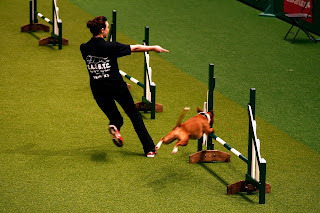 |
| Honey & her owner's bond is evident to see |
... using the W O W factor!
As you’d expect, being a Puppy School tutor, I’m passionate about providing puppies and their families with the best training and behaviour advice. Whilst a puppy is often likened to a blank sheet and thought of as being easy to train, it’s important to remember that a mistake with a puppy’s training can be like an indelible ink blot on the blank sheet - it leaves its mark.Puppy training classes should provide you with the tools to bond with your puppy and help educate them (and you) to grow into a well mannered and sociable adult dog.
I’ve experienced at first hand the behaviour problems that can result from lack of appropriate training and positive experiences as a puppy. All three of my dogs are rescues. Mina was found as a stray puppy and as such, probably didn’t have the best start in life. As a result, I believe a lot of Mina’s behaviour problems (now conquered) stemmed from a lack of positive experiences and training as a pup.
And for the majority of racing greyhounds, socialisation isn’t particularly high up on the agenda for most kennels. This means that many of the day to day activities and experiences that pet puppies become accustomed to, and most pet dogs take in their stride, can be daunting experiences for some retired greyhounds.
 |
| Instructors are trained to high standards |
A chat and catch-up with Gwen Bailey
When I was at Crufts, I managed to catch up with Gwen Bailey, the founder and director of Puppy School. I asked Gwen about the importance of puppy training, as well as how to find a good puppy class. Gwen also shared the reasons why she set up Puppy School.
You can listen to the interview below.
Not all puppy classes are the same
If you’re looking for a puppy class, how do you know which is a good class? There are lots of classes out there and some are better than others.Naturally, I would suggest a Puppy School class, as all tutors are trained to high standards in dog behaviour and training. However, if there isn’t a Puppy School class near you, here are some tips to help you find the right class for you and your puppy, handily summarised as the WOW (Which? Observe. What?) factor!
1. Which class?
Do your research. Ask your vet if they can recommend any classes and ask any friends or colleagues who have had puppies which classes they attended. Don’t just take their word for it though, if you’ve found some classes you like the sound of, ring and ask if you can go along and watch a class (without your puppy). |
| Go along and watch a class |
2. Observe
When you’re at the class watch what’s going on. It can be tempting just to focus on the cute puppies, but you need to look past this.How are the puppies and their families enjoying class? Are they relaxed and having fun, or are they stressed? Are the puppies barking lots, or are any of the puppies looking nervous and trying to hide? How many puppies are there in class? Is it a free for all, or are the classes structured? Does the instructor engage the class? How does the instructor deal with any problems? Is any puppy play monitored and interrupted regularly so that puppies learn appropriate play?
 | |
| Charlie learns to relax with the help of a pizzle stick and a Kong |
If there are lots of barking puppies and the instructor uses anything like a rattle can (can or bottle full of stones), water sprays, training discs or a pet corrector to interrupt the barking – this is another red flag. The use of these techniques may stop the barking, as they startle the puppies, but they can make the puppy afraid of loud noises and are certainly not going to help the puppies relax and enjoy the class.
Teaching any dog should not involve any harsh or aversive methods. On the surface, these methods may appear to work, but more often than not they leave lasting invisible scars and psychological damage.
3. What? – ask questions
Don’t be afraid to ask questions! You wouldn’t hire a plumber without making sure they were suitably qualified and experienced. The same is true for dog training instructors. Ask about their qualifications and experience. |
| Monty's owner uses reward based methods |
What equipment do they use to train? Choke/check chains, prong collars, shock collars or citronella (anti-bark) collars have no place in dog training.
What is the maximum number of puppies allowed in class? (Both Puppy School and the Association of Pet Dog Trainers, UK, recommend no more than 8 puppies per instructor). A small class means more attention from the instructor and more space for puppies to work in.
 |
| Fingal & Rasta enjoy and learn from supervised puppy play |
Finding a qualified instructor:
There are a number of organisations that provide details of qualified instructors. The ones I would recommend are:- Puppy School – www.puppyschool.co.uk
- Association of Pet Dog Trainers – www.apdt.co.uk
Trainers who are Puppy School tutors and/or members of the APDT have gone through rigorous assessments for both their theoretical knowledge and practical skills for running classes.
Let me know what you think...what have been your experiences of puppy classes?
NB: All photos are copyright of Susan McKeon & Puppy School North Lincolnshire




